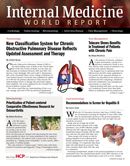Prioritization of Patient-centered Comparative Effectiveness Research for Osteoarthritis
As the life expectancy of patients continues to grow, healthcare professionals are seeing a rise in cases of osteoarthritis in their case files and are charged with discovering the best treatment possible for them.

As the life expectancy of patients continues to grow, healthcare professionals are seeing a rise in cases of osteoarthritis (OA) in their case files and are charged with discovering the best treatment possible for them.
In a study published in the Annals of Internal Medicine, the authors took a closer look at what they described as a “leading cause of disability” in this country, affecting nearly 27 million people. They also looked at “evidence gaps,” which come with those courses of treatment and diagnosis. Citing a Framingham Heart Study cohort, the authors said cases of knee OA has increased by 4.1% in women and 6% among men in the past 20 years alone.
As part of their research, the authors worked with a group of 13 stakeholders that included experts and researchers in the field, people in government and nongovernmental roles, and agencies and professional societies with expertise in the field, among others. The participants were then asked to rank the evidence gaps in order of importance.
A large database search for clinical studies conducted had resulted in a possible pool of 4,692 studies, which researchers eventually narrowed down to 427 meeting more specific criteria. A group also worked to find “study designs to address the stakeholders’ highest ranked research areas.”
Participants in the evidence gap portion of the study expanded the original list of evidence gaps from 31 to 48 as part of their initial work with a focus on researching ways to engage patients early in the process to help navigate the initial stages. They also stressed searching for methods to make “long-term engagement in nonsurgical options” a priority.
After the full rankings were completed, the top priorities, according to the authors, focused on “identifying key patient-centered outcomes.” These included duration, intensity, and frequency of treatments and looking at the socioeconomic differences between patient care options at the top of the list.
The authors noted that the diagnosis of OA alone can be difficult as it can require a complete medical history, a physical exam, and laboratory testing and radiographic studies before treatment can even fully begin. Treatment also comes with a significant price tag, according to the authors, with more than 900,000 people reporting being hospitalized as a result of the condition between 1997 and 2009. Patients with OA are also reported to have healthcare costs close to 50% higher than those who do not suffer from that particular arthritis.
Outside of hospitalization, the authors said the most popular nonsurgical treatment options include analgesics and anti-inflammatory drugs. Some patients have also made progress by working on their weight management and physical conditioning.
“Given the high prevalence of OA and the effect on function status, productivity, and quality of life, optimizing treatments to stabilize symptoms, reduce pain, and maintain functional status should be a high priority,” the authors wrote. “To advance a patient-centered research agenda, future research should focus on addressing patients’ needs across the disease spectrum and enhancing long-term engagement strategies that stabilize the symptoms of OA.”
Funding for the study was provided by the Patient-Centered Outcomes Research Institute who also “provided suggestions to clarify language describing the process in selecting this topic for prioritization,” after receiving a draft of the study results.
